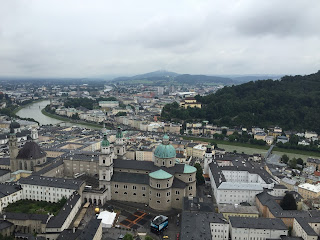 |
| On the train headed to Salzburg |
We loved traveling the two hours on the train from Munich to Salzburg. The trains were comfortable, clean and provided great views of the countryside. Unfortunately it was raining but we had our rain gear and were ready for the adventure. We had booked a tour since we knew we only had a short time in the city and wanted to see as much as we could. Susan, our tour guide, shared her wealth of knowledge with us.
 |
| Pegasus in Mirabell Gardens |
Our tour began at the Mirabell Palace built in 1606 by the Archbishop von Raitenau for his mistress and their 15 children. The baroque Palace is used as a Municipal building today. The Gardens, designed in 1690, were beautifully manicured. The pink, yellow and red flowers were lovely against the green grass. The pathways lined with trees created a walkway from the Palace towards a view of the Fortress at the top of the hill. We stood around the Pegasus statue and walked down the steps where the "von Trapp family" played and sang "do-re-mi".
We walked across the Salzach River on a bridge covered with love locks. Padlocks with the initials of the lovers were locked onto the bridge signifying the permanence of the relationship. The custom began over 100 years ago in Italy but only recently became popular in the rest of Europe. The city and river got its name from the salt mines in the area. The mine in Salzburg has been worked for over 7000 years and the river was used to transport the salt throughout the region making this area an important transportation route. That, and the gold that was mined here too.
 |
| The Salzach River and Salzburg Cathedral |
 |
| Even McDonald's sign has to be like the rest |
While we walked down Getreidegasse street we saw signs above the doors that indicated what products the store sold. These signs have been used for centuries and new stores must use them still today. People have lived in Salzburg since 15 BC and due the illiteracy of the peasants during that time pictures were used to tell the story. I have been using this method as I shop for 6 months now and it is very effective.
We saw Alter Markt where dairy products, herbs, turnips and cabbages had been sold since the 13th century and also where dances and festivals were held. St. Florian's statue has sat on the well in the center of the market since 1488. Wells were important not only for drinking water but also to put out the frequent fires in the city. Cafe Tomaselli, where Mozart had his coffee, occupied a corner of the square.
 |
| The fountain in front of the New Palace |
 |
| The ornate Salzburg Cathedral |
The Salzburg Cathedral captured our attention as we stood in front of the entrance. In the 1600's it was built out of white marble from the nearby Alps but there has been a church on this site since 774. When the original church was severely damaged this current building was built on the old foundation. There were four statues at the three entrance doors; St Rupert holding a salt barrel, St. Peter holding keys, St. Paul holding a sword and St Virgilius holding a church. Inside the Cathedral were high arched ceilings covered with ornate carvings. We sat inside for a few moments appreciating our surroundings.
A large stage filled the Domplatz (courtyard of the church) because the 2015 Salzburg Festival was occurring and concerts were happening throughout the city for 6 weeks. We heard music everywhere; violins, guitars, accordions, water goblets all sounded beautiful in the hands of skilled musicians.
 |
| Inside St. Peter's Abbey |
I especially enjoyed the painting on the ceiling depicting Peter walking on the water but all of the paintings were inspiring.
Next to the church is a restaurant founded by the monks of the Abbey over a thousand years ago. It has served traditional Austrian food since 803. We peeked inside to see the restaurant courtyard and the rooms cut out of the mountain.
We walked through St. Peter's cemetery alongside the side of the Abbey. It is where the "Sound of Music" filmed the von Trapp's escape from the Nazi's.
 |
| Hohensalzburg Fort from the Abbey cemetery |
 |
| Sound of Music marionettes |
Sadly enough it was time to leave Salzburg. We loved our time in the city. There will always be more to discover but for now we echo "so long, farewell, auf wiedersehen, adieu."
This comment has been removed by the author.
ReplyDelete